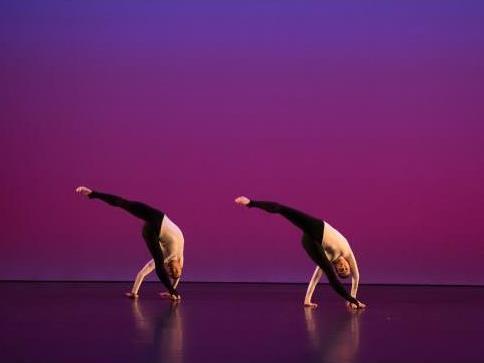Photo credit: Hugo Glendinning
Based in London, the Michael Clark Company is renowned for its technical rigour and experimentation. Clark, the Artistic Director and choreographer trained at the Royal Ballet School in London and also with Merce Cunningham and John Cage. His first choreographed piece was in 1982; in 1984 he founded his own company, which has toured worldwide, while in 2005 he became Artistic Associate of the Barbican Centre. Clark may be remembered as Caliban in Peter Greenaway’s Prospero’s Books (1991). Known for his provocative use of punk music and bare bottomed dancers, he has come back to minimalism with this work.
First seen at the Barbican Centre in 2016, this triptych was presented at the Sydney Opera House before crossing the country for its Perth Festival season. Implying a passionate response by evoking rock ‘n roll in the title, in a nod to the Patti Smith song, this Clark-choregraphed dance work has been greatly anticipated, however it seemed more about admiring the ease with which the dancers coolly exerted control over their bodies, rather than extending any great emotional energy to the audience.
Act I, entitled Satie Studs/Ogives Composite felt highly conceptual. Every moment was tightly choreographed and the formality of it did not allow for one’s own emotional input as a reaction to the piece. Seven dancers on stage: arms fly up and down, sculptural constructions, two dancers skitter across the stage. These moments are interspersed with dancers like puppets on a string; highly coordinated and hypnotic. Legs leading them across stage and moving into Pilates/yoga style movements that seem to provide an aspirational need for some of the audience members to comment on. More robot-like angular movements, two dancers exit stage right and two more enter stage left. The Dada-esque links of the choreography become clearly articulated towards the end of Act I with leaps and jumps to the discordant Satie piano music. We are privy to a very ordered chaos on stage and Jacques Tati is brought to mind.
The costumes designed by Stevie Stewart (who created costumes for Kylie Minogue’s KYLIEX2008 tour) and Michael Clark are no frills, revealing all aspects of these incredibl dancers’ musculature. In the first act we begin with tight white high neck skivvies and black bottomed unitards. As the acts progress we move into some colour, with gleaming bronze unitards and some 70’s flared styles for the Patti Smith number, concluding with a sunset sinking orange glow costume. The women with their tight chignons echoing the classical minimalism of these works.
Act II entitled Land was accompanied by Patti Smith songs that echo the times, further enhanced by a stage adaption of Painting by Numbers by Charles Atlas, a multi-channel video installation first shown in London, 2010. The video work was mesmerizing with its cacophony of moving numbers. Disco origin moves provided further contextualization to a 1970’s psychedelic nightclub atmosphere. The most provocative moves were the dancers bent over with their hands back up grasping their butts. Then numbers of them did this at once and hopped around, showing the humour of Clark’s choreography.
There is elegance, control, and yes, collaboration in that so many of the staccato, pinball-machine type moves rely on great coordination; they are almost perfectly synchronized. Overall the lack of human touch on stage contributed to the feeling of coldness and control, as each dancer was perfect in their own performance, however the great use of singularity was not to my taste.
A major highlight of the performances is the work of Charles Atlas who has worked in film and video for over four decades, with work included in permanent collections of major institutions worldwide. He’s responsible for the lighting as well as the video work accompanying Act II. Especially memorable are the intense hues of the lighting as it gradually shifts from pink to red to orange to yellow in the first Act. The suffused pink as background to the singular silhouetted dancer at the back of the stage was stunning. The lighting of the red backdrop screen is unforgiving of any small errors in loss of stamina in endless holds. The dancers’ bodies are provided acuity in this starkness of bold colour as we observe every part of them in motion.
Once the passionate voice of David Bowie came into the equation for Act III, by general consensus it seemed the works were more appreciated. Act III, my mother, my dog and CLOWNS! included more formation, and synchronicity with the addition of what could be seen as a priest, dressed in a long black dress, swinging in and out of the stage with arms horizontally lifted. The dancing to Bowie’s Blackstar – his more recent work – was a personal favourite. There was some beautifully choreographed backward stepping as well as the use of humorous feet movements. The lyrics including ‘how many times does an angel fall?’ provided more imaginative leeway for the viewer, and the passion of this dance was seen, including some whirling dervish moves. Aladdin Sane concluded the set of four works after the interval.
Overall, with the sometime discordant tones of Satie and the Patti Smith song, the works were not integrating into an emotional energy that was conveyed to the audience. Despite sustained clapping, the audience seemed somewhat underwhelmed by this season of the renowned Michael Clark’s choreography but in admiration of the dance troupe’s sustained technical perfection.
Rating: 3 ½ stars out of 5
To a Simple Rock ‘N’ Roll… Song
Choreographer: Michael Clark
Lighting Designer: Charles Atlas
Costumes: Stevie Stewart & Michael Clark
Dancers: Harry Alexander, Daniel Corthorn, Sophie Cottrill, Kieran Page, Oxana Panchenko, Rowan Parker, Alice Tagliento, Benjamin Warbis.
His Majesty’s Theatre, Perth
14 February – 17 February 2018
As part of Perth Festival





